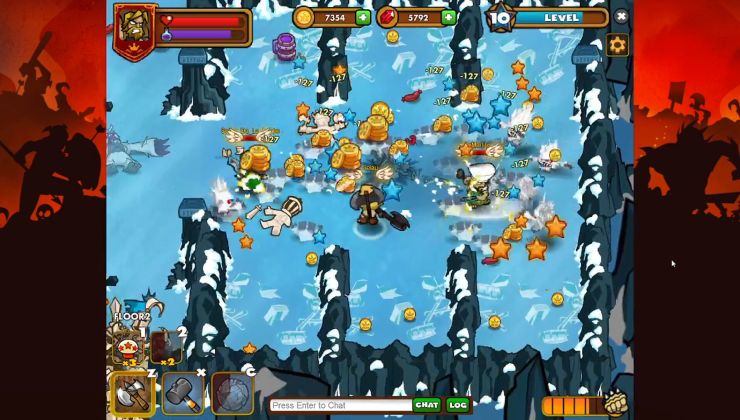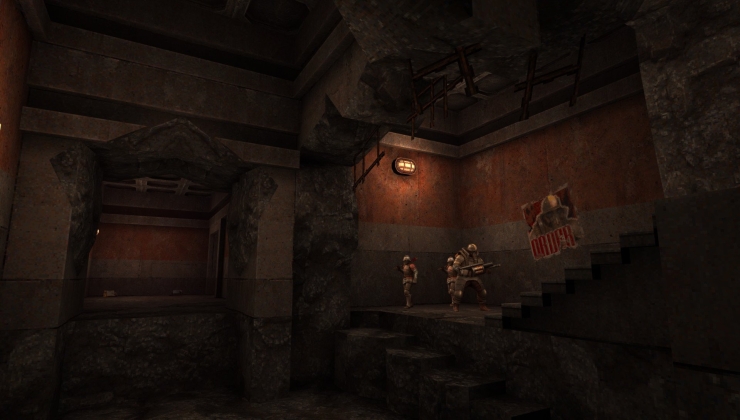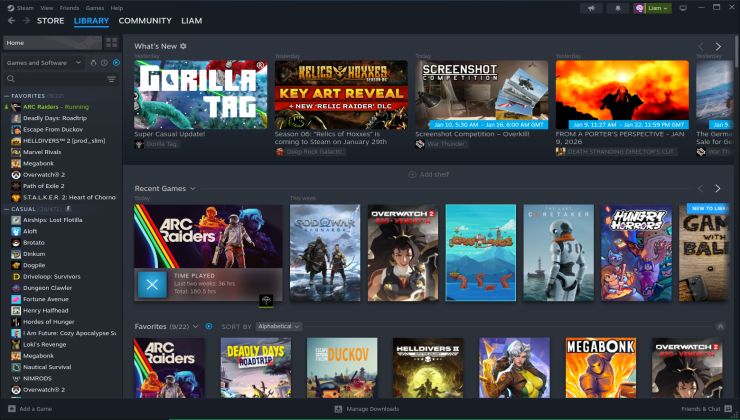This is your once a month reminder to make sure your PC information is correct on your user profiles. A fresh batch of statistics is generated on the 1st of each month.
[pcinfo]
You can see the statistics any time on this page.
PC Info is automatically purged if it hasn't been updated, or if you don't click the link to remain in for 2 years. This way we prevent too much stale data and don't hold onto your data for longer than required. If this is still correct and it has been a long time since you updated, you can simply click here to continue to be included. If this isn't correct, click here to go to your User Control Panel to update it!
Some you may have missed, popular articles from the last month:
All posts need to follow our rules. Please hit the Report Flag icon on any post that breaks the rules or contains illegal / harmful content. Readers can also email us for any issues or concerns.
Spoiler, click me
External Media: You need to be logged in to view this.
8 Likes
Figured I'd take a look at the trends since I haven't done so in quite a while, and point out anything that looks interesting.
Distributions mostly hold flat with some minor wiggles, other than what looks like a long slow decline in Ubuntu and a remarkable doubling in share for Manjaro, from 7.58% in February 2019 to 15.18% today.
8 GB of RAM and 32 GB of RAM have basically traded usage share (with 32 GB on the rise), though both are dwarfed by the 16 GB share, which has held between 51% and 54% the entire period plotted. :shock: (I'm in the somewhat-odd spot of having 24 GB myself, due to half-upgrading when one of my four 4 GB modules failed a few years ago.)
Intel and AMD usage has been steadily converging, with Intel at 52.32% and AMD at 47.68%—a rough calculation puts the slope at about ±0.95% per month, which suggests they might reach parity or even cross over in about 5 months if the trend holds. (I'm considering going AMD at some point in the future, but given my computer still works fine and that would require a new motherboard I can't really see myself justifying it anytime in the near future given my current financial situation as a poor graduate student. :whistle:)
Similarly, Nvidia is slowly dropping while AMD is growing (and Intel holds pretty flat) for GPUS, though the difference between Team Green and Team Red is still 19.22 percentage points, so unless the trend changes it'll be years before they reach parity. And didn't I hear some news about Intel releasing new GPUs or something recently? So who knows how this'll go. (I'll probably go full AMD whenever I do that motherboard switch mentioned above, which means…not for the next year or so at least, probably.)
Proprietary vs. open source GPU drivers are trending similar to Nvidia vs. AMD, I'm guessing because people using AMD are generally also using the open source driver, maybe? Oh, yeah, the next two plots show that roughly 97% of Nvidia users use the proprietary driver (I'm in this camp), while roughly 95% of AMD users use the open source one.
A single monitor remains the overwhelmingly most common option, but it's actually trending down very slightly over time. Very interestingly, the slack is not being picked up by 2 monitors as I would've thought (that's stayed more-or-less the same), but 3 monitors. Though we're talking like 1 percentage point here, so it's not huge. (I'm *sigh* stuck with 1 monitor for now, though I've had 2 in the past, and am eagerly looking forward to an eventual 3-monitor setup of my own in the future for increased productivity. :wub:)
Resolution-wise, 1920×1080 remains the most common by a country mile, at 56% currently, though that's dropped from just under 60% in February 2019. It looks like most of the gains have been made up by 2560×1440, which went from 10.12% to 14.84% in that same time. 3840×2160 (4K) also seems to have gained ~2% over that time, up to 7.78% now. (I think my next monitor upgrade [to accompany this mythical general computer upgrade in the misty future] will include jumping from 1080p to 4K on one of those two or three monitors; I kinda held off before as I didn't have the strongest GPU, but I've realized since then that most of the games I play are really not that graphically demanding anyway, and I expect the extra space will help with productivity as well. Plus I'd like to get into videography with stuff capable of shooting at 4K, and there's not much point in making it if I can't actually see it on my screen. :grin:)
There's more, but that's the stuff I find interesting, or which had interesting-looking trends.
Distributions mostly hold flat with some minor wiggles, other than what looks like a long slow decline in Ubuntu and a remarkable doubling in share for Manjaro, from 7.58% in February 2019 to 15.18% today.
8 GB of RAM and 32 GB of RAM have basically traded usage share (with 32 GB on the rise), though both are dwarfed by the 16 GB share, which has held between 51% and 54% the entire period plotted. :shock: (I'm in the somewhat-odd spot of having 24 GB myself, due to half-upgrading when one of my four 4 GB modules failed a few years ago.)
Intel and AMD usage has been steadily converging, with Intel at 52.32% and AMD at 47.68%—a rough calculation puts the slope at about ±0.95% per month, which suggests they might reach parity or even cross over in about 5 months if the trend holds. (I'm considering going AMD at some point in the future, but given my computer still works fine and that would require a new motherboard I can't really see myself justifying it anytime in the near future given my current financial situation as a poor graduate student. :whistle:)
Similarly, Nvidia is slowly dropping while AMD is growing (and Intel holds pretty flat) for GPUS, though the difference between Team Green and Team Red is still 19.22 percentage points, so unless the trend changes it'll be years before they reach parity. And didn't I hear some news about Intel releasing new GPUs or something recently? So who knows how this'll go. (I'll probably go full AMD whenever I do that motherboard switch mentioned above, which means…not for the next year or so at least, probably.)
Proprietary vs. open source GPU drivers are trending similar to Nvidia vs. AMD, I'm guessing because people using AMD are generally also using the open source driver, maybe? Oh, yeah, the next two plots show that roughly 97% of Nvidia users use the proprietary driver (I'm in this camp), while roughly 95% of AMD users use the open source one.
A single monitor remains the overwhelmingly most common option, but it's actually trending down very slightly over time. Very interestingly, the slack is not being picked up by 2 monitors as I would've thought (that's stayed more-or-less the same), but 3 monitors. Though we're talking like 1 percentage point here, so it's not huge. (I'm *sigh* stuck with 1 monitor for now, though I've had 2 in the past, and am eagerly looking forward to an eventual 3-monitor setup of my own in the future for increased productivity. :wub:)
Resolution-wise, 1920×1080 remains the most common by a country mile, at 56% currently, though that's dropped from just under 60% in February 2019. It looks like most of the gains have been made up by 2560×1440, which went from 10.12% to 14.84% in that same time. 3840×2160 (4K) also seems to have gained ~2% over that time, up to 7.78% now. (I think my next monitor upgrade [to accompany this mythical general computer upgrade in the misty future] will include jumping from 1080p to 4K on one of those two or three monitors; I kinda held off before as I didn't have the strongest GPU, but I've realized since then that most of the games I play are really not that graphically demanding anyway, and I expect the extra space will help with productivity as well. Plus I'd like to get into videography with stuff capable of shooting at 4K, and there's not much point in making it if I can't actually see it on my screen. :grin:)
There's more, but that's the stuff I find interesting, or which had interesting-looking trends.
14 Likes
Great writeup, Phil, thanks for taking the time to do this. Observing trends is always very interesting and GOL's stats are a splendid tool.
1 Likes
Quoting: PhiladelphusFigured I'd take a look at the trends since I haven't done so in quite a while, and point out anything that looks interesting.I've noticed similar with less precision by eye-balling the changes over the last year or so. I find it worth mentioning that the GoL folks who enter their system specs into the survey have a very different hardware base than Steam statistics.
Distributions mostly hold flat with some minor wiggles, other than what looks like a long slow decline in Ubuntu and a remarkable doubling in share for Manjaro, from 7.58% in February 2019 to 15.18% today.
8 GB of RAM and 32 GB of RAM have basically traded usage share (with 32 GB on the rise), though both are dwarfed by the 16 GB share, which has held between 51% and 54% the entire period plotted. :shock: (I'm in the somewhat-odd spot of having 24 GB myself, due to half-upgrading when one of my four 4 GB modules failed a few years ago.)
Intel and AMD usage has been steadily converging, with Intel at 52.32% and AMD at 47.68%—a rough calculation puts the slope at about ±0.95% per month, which suggests they might reach parity or even cross over in about 5 months if the trend holds. (I'm considering going AMD at some point in the future, but given my computer still works fine and that would require a new motherboard I can't really see myself justifying it anytime in the near future given my current financial situation as a poor graduate student. :whistle:)
Similarly, Nvidia is slowly dropping while AMD is growing (and Intel holds pretty flat) for GPUS, though the difference between Team Green and Team Red is still 19.22 percentage points, so unless the trend changes it'll be years before they reach parity. And didn't I hear some news about Intel releasing new GPUs or something recently? So who knows how this'll go. (I'll probably go full AMD whenever I do that motherboard switch mentioned above, which means…not for the next year or so at least, probably.)
Proprietary vs. open source GPU drivers are trending similar to Nvidia vs. AMD, I'm guessing because people using AMD are generally also using the open source driver, maybe? Oh, yeah, the next two plots show that roughly 97% of Nvidia users use the proprietary driver (I'm in this camp), while roughly 95% of AMD users use the open source one.
A single monitor remains the overwhelmingly most common option, but it's actually trending down very slightly over time. Very interestingly, the slack is not being picked up by 2 monitors as I would've thought (that's stayed more-or-less the same), but 3 monitors. Though we're talking like 1 percentage point here, so it's not huge. (I'm *sigh* stuck with 1 monitor for now, though I've had 2 in the past, and am eagerly looking forward to an eventual 3-monitor setup of my own in the future for increased productivity. :wub:)
Resolution-wise, 1920×1080 remains the most common by a country mile, at 56% currently, though that's dropped from just under 60% in February 2019. It looks like most of the gains have been made up by 2560×1440, which went from 10.12% to 14.84% in that same time. 3840×2160 (4K) also seems to have gained ~2% over that time, up to 7.78% now. (I think my next monitor upgrade [to accompany this mythical general computer upgrade in the misty future] will include jumping from 1080p to 4K on one of those two or three monitors; I kinda held off before as I didn't have the strongest GPU, but I've realized since then that most of the games I play are really not that graphically demanding anyway, and I expect the extra space will help with productivity as well. Plus I'd like to get into videography with stuff capable of shooting at 4K, and there's not much point in making it if I can't actually see it on my screen. :grin:)
There's more, but that's the stuff I find interesting, or which had interesting-looking trends.
2 Likes
Quoting: 14I've noticed similar with less precision by eye-balling the changes over the last year or so. I find it worth mentioning that the GoL folks who enter their system specs into the survey have a very different hardware base than Steam statistics.People who register on gaming websites likely represent a very different consumer segment than all the people that click "OK" on the Steam survey. In the GOL surveys the more casual segment will naturally be absent and thus the survey trends towards people who are making very conscious hardware purchases.
2 Likes
I actually needed the reminder to change my hardware information for once. So thanks. :wink:
1 Likes
Nice write-up Phil. I love data analysis.
My base system has changed from Intel to AMD over that time (4790 -> 3700X). My video card is Nvidia but I plan on upgrading once AMD releases their cards this fall. I'm not very impressed with Nvidia's release, but will wait to compare them once I can see good results from Phoronix, Anand, and a few others.
Since early 2019 I've gone the other direction with monitor count. I had 3 at work and 2 at home. I'm now single monitor in both places. Now I prefer to use workspaces or just minimize remote desktops. For my workflow I found it didn't increase productivity, just spread my mess out across more screens and take up more space.
My base system has changed from Intel to AMD over that time (4790 -> 3700X). My video card is Nvidia but I plan on upgrading once AMD releases their cards this fall. I'm not very impressed with Nvidia's release, but will wait to compare them once I can see good results from Phoronix, Anand, and a few others.
Since early 2019 I've gone the other direction with monitor count. I had 3 at work and 2 at home. I'm now single monitor in both places. Now I prefer to use workspaces or just minimize remote desktops. For my workflow I found it didn't increase productivity, just spread my mess out across more screens and take up more space.
1 Likes
Well, nothing interesting for my PC info except fully switched to Mint (not LMDE one). Guess it's still hard for me to seperate from PPA ecosystem. Yep.
Oh, and my Logitech Unifying keyboard not recognized in-between keystroke if I type very fast. Probably the time has come and to drying up my already thin wallet.
Oh, and my LCD screen already burnt little by little. My wallet...
Oh, and I still need to find a permanent, stable and hopefully better paid jobs. Unemployed ain't fun.
So yeah..
Serious question
Liam (or anyone). Is running Windows XP on virtualization software considered as dual boot? May need to run XP to use Nokia PC suite for set up old Nokia S40 phone.
Oh, and my Logitech Unifying keyboard not recognized in-between keystroke if I type very fast. Probably the time has come and to drying up my already thin wallet.
Oh, and my LCD screen already burnt little by little. My wallet...
Oh, and I still need to find a permanent, stable and hopefully better paid jobs. Unemployed ain't fun.
So yeah..
Serious question
Liam (or anyone). Is running Windows XP on virtualization software considered as dual boot? May need to run XP to use Nokia PC suite for set up old Nokia S40 phone.
1 Likes
Quoting: tonRLiam (or anyone). Is running Windows XP on virtualization software considered as dual boot? May need to run XP to use Nokia PC suite for set up old Nokia S40 phone.I don't make the rules, but my opinion would be that day-to-day active virtualization should count as dual-boot but also you shouldn't count it as a dual-boot if you just briefly touch a Windows system. So if it's just a matter of setting up a phone and you aren't actually using that XP system for anything else, I wouldn't count it.
2 Likes
Quoting: tonRLiam (or anyone). Is running Windows XP on virtualization software considered as dual boot? May need to run XP to use Nokia PC suite for set up old Nokia S40 phone.If you want to be more literal about the Dual-Boot specification, I take it to mean that the alternative OS is accessible on the Boot Menu. I think firing up a Windows VM for a miniscule use wouldn't count as dual-boot (and same with all the other VMs you might fire up from time to time).
Maybe you could access your Nokia Suite software using WINE instead?
3 Likes
Quoting: SamsaiEspecially since this is a gaming oriented survey and you are not using the VM for gaming.Quoting: tonRLiam (or anyone). Is running Windows XP on virtualization software considered as dual boot? May need to run XP to use Nokia PC suite for set up old Nokia S40 phone.I don't make the rules, but my opinion would be that day-to-day active virtualization should count as dual-boot but also you shouldn't count it as a dual-boot if you just briefly touch a Windows system. So if it's just a matter of setting up a phone and you aren't actually using that XP system for anything else, I wouldn't count it.
2 Likes
Quoting: SamsaiI don't make the rules, but my opinion would be that day-to-day active virtualization should count as dual-boot but also you shouldn't count it as a dual-boot if you just briefly touch a Windows system. So if it's just a matter of setting up a phone and you aren't actually using that XP system for anything else, I wouldn't count it.Understood. So, I'm not changing dual-boot question.
Quoting: g000hMaybe you could access your Nokia Suite software using WINE instead?Well, using WINE is kinda hit-and-miss and happened once time my phone got factory reset, try it before and won't do it again.
Also, I'm afraid to run XP directly without any sandboxing nowadays. Especially my Win XP is "buried treasury" version. :tongue:
1 Likes
Quoting: damarrinGreat writeup, Phil, thanks for taking the time to do this. Observing trends is always very interesting and GOL's stats are a splendid tool.Cheers! I actually surprised myself with how long it came out. Guess it was a slow lockdown day here in Melbourne. :happy:
0 Likes
Yesterday's notification: Your PC information hasn't been updated in a few months - be sure to keep it up to date!
My "Computer info" page says: You last updated yours: 25 Sep, 2020
I feel a great disturbance in the Force. :grin:
My "Computer info" page says: You last updated yours: 25 Sep, 2020
I feel a great disturbance in the Force. :grin:
1 Likes
Huh, I got the same notification (with the last update day being one day later). :dizzy:
1 Likes









 How to setup OpenMW for modern Morrowind on Linux / SteamOS and Steam Deck
How to setup OpenMW for modern Morrowind on Linux / SteamOS and Steam Deck How to install Hollow Knight: Silksong mods on Linux, SteamOS and Steam Deck
How to install Hollow Knight: Silksong mods on Linux, SteamOS and Steam Deck